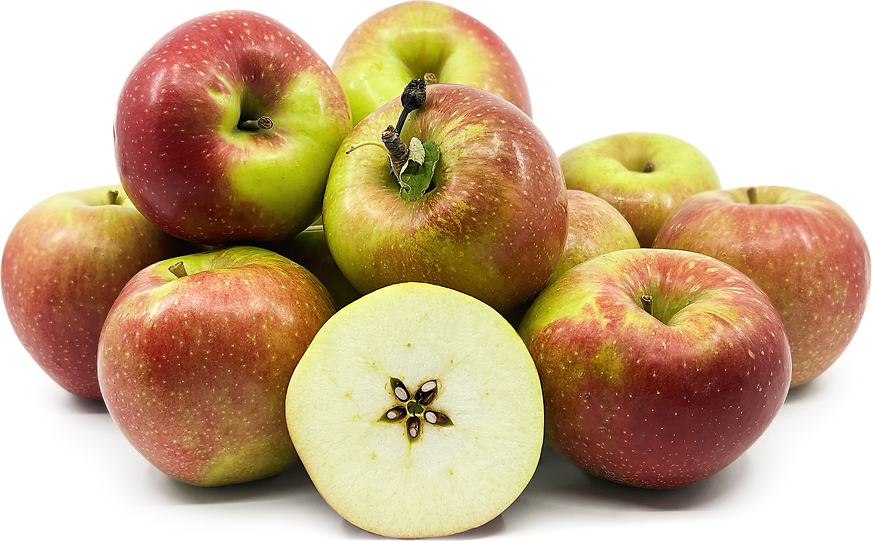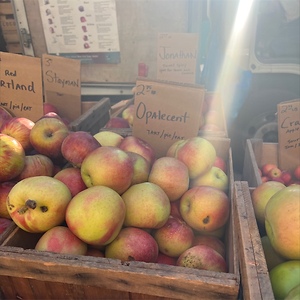


Opalescent Apples
Estimated Inventory, lb : 0
Description/Taste
Opalescent apples are a medium to large variety, depending on growing conditions, and generally have a round to conical shape. The fruits often feature slanted sides or a slightly lopsided appearance and have a short, thick, woody stem set in a narrow, deep cavity. The apple’s skin is semi-thick, smooth, and taut, sometimes showcasing ribbing or patches of russet in the stem cavity and across the surface. Opalescent apples have a yellow-green base hue and are covered in large patches of dark red, crimson blush. When exposed to large amounts of sunlight, some fruits can develop a dark red, almost purple hue. The surface is also covered in prominent yellow to tan lenticels, and as the apple matures, it develops a greasy, waxy coating. Underneath the surface, the cream-colored to pale yellow flesh is firm, dense, and moderately aqueous with a crunchy, crisp consistency. Opalescent apples are aromatic and edible raw or cooked once ripe. The variety is known for its balanced, sweet-tart taste combined with fruity and floral nuances. Some consumers note that the apples bear subtle notes reminiscent of strawberries, lilacs, pineapples, and honey.
Seasons/Availability
Opalescent apples are available in the late summer through early fall, typically harvested in August and September. Once picked, the variety can be stored for several months into the mid to late winter.
Current Facts
Opalescent apples, botanically classified as Malus domestica, are an American variety belonging to the Rosaceae family. The mid-season cultivar was discovered growing as a chance seedling in the late 19th century in Michigan and was selected for cultivation for its balanced, sweet-tart flavoring. Opalescent apples are an heirloom variety known for their hardiness and vigorous nature. The apples were once a well-known cultivar planted in home gardens and were valued for their ability to hang well on the tree and store for extended periods. Opalescent apples are considered rare in the present day, but the variety is still sought by home growers for the versatility of the fruit. The variety is dual-purpose and can be eaten fresh or incorporated into a wide array of sweet or savory cooked culinary preparations.
Nutritional Value
Opalescent apples have not been extensively studied for their nutritional properties. Apples, in general, are a fiber source to aid digestion and contain minerals like magnesium, manganese, phosphorus, calcium, and potassium. Magnesium assists the body in regulating daily nerve functions, while manganese contributes to connective tissue development. Phosphorus and calcium support bone and teeth health, and potassium helps to balance fluid levels within the body. Apples also provide vitamins A, C, E, and K to aid in faster wound healing, strengthen the immune system, protect organs, and guard the cells against the damage caused by free radicals.
Applications
Opalescent apples have a sweet-tart flavor suited for raw and cooked preparations. The variety was famous in the early 20th century as a fresh-eating apple, consumed out of hand or sliced into wedges. Opalescent apples can also be cut and tossed into salads, served on cheese plates, or shredded into slaws. The apple’s drier nature complements mixing it into grain bowls without adding excess moisture and is sometimes used as a topping over parfaits, oatmeal, and other breakfast dishes. In addition to fresh preparations, Opalescent apples are occasionally simmered into jams, jellies, and compotes or cooked into sauces. These sauces can be drizzled over roasted meat or used as fillings in baked goods like turnovers. Try incorporating Opalescent apples with other apple varieties into cakes, pies, crisps, and crumbles. They can also be roasted with root vegetables as a savory side. Opalescent apples pair well with spices like nutmeg, cinnamon, and cardamom, nuts including almonds, walnuts, and hazelnuts, and meats such as pork, beef, and poultry. Whole, unwashed Opalescent apples will keep for several weeks to months when stored in a cool, dry, and dark location, like a cellar or the refrigerator’s crisper drawer.
Ethnic/Cultural Info
Opalescent apples have been known by several names throughout their history. When the variety was discovered, it was initially called Hudson’s Pride, named after their founder, George Hudson. Some records also note that it was called Hudson’s Pride of Michigan. Later, when Mr. Hudson submitted the variety to the United States Department of Agriculture, the variety’s name was called Hastings. It is unknown who requested the name change, as some sources claim that Mr. Hudson requested the change, while other sources note that the American Pomological Society may have named the apples Hastings in honor of the township where the seedling was found. Despite this change, the variety’s name was altered again in the late 19th century when it was acquired by Dayton Star Nurseries. The commercial nursery rebranded the apples as Opalescent to highlight their bi-colored nature. Opalescent quickly became the dominant moniker and is the name used in the modern day.
Geography/History
Opalescent apples were discovered growing as a chance seedling in Barry County, Michigan, in the late 19th century. The most prevalent theory traces the variety to a man named George Hudson, who noticed a group of apple seedlings growing on his property while he was clearing oak stumps sometime in the 1870s or 80s. Mr. Hudson chose the most vigorous seedling and planted it in his orchard, allowing it to mature and bear fruit. He later sent fruit samples to the United States Department of Agriculture. The apples were acknowledged as a new variety by the USDA and the American Pomological Society and were initially released to the public through Dayton Star Nurseries in 1899 in Xenia, Ohio, under the name Opalescent. After its release, Opalescent apples became a favored home garden variety and were offered through nurseries in the 1920s and 30s as a dual-purpose tree. The variety remained a popular cultivar for several decades but eventually faded from production as newer, modern varieties were introduced. Today, Opalescent apples are an heirloom variety only found through specialty growers, mainly in the United States, Canada, and on a smaller scale in Europe. The variety is seasonally offered through farmers’ markets and select wholesalers.
Recipe Ideas
Recipes that include Opalescent Apples. One
| Common Sense Homesteading |
|
Apple Scrap Vinegar |
| Bewitching Kitchen |
|
Raw Apple Pie |
| This Rawsome Vegan Life |
|
Caramel Apples |









